
Gabrielle Bonheur Chanel, famously known as Coco Chanel, stands as one of the most influential figures in fashion history. She not only redefined women’s fashion but also challenged societal norms and reshaped the idea of femininity itself. From her revolutionary designs like the Little Black Dress (LBD) and the Chanel suit to her iconic perfume, Chanel No. 5, her legacy transcends generations. But how did a girl from humble beginnings rise to dominate the world of luxury fashion? Let’s explore the incredible life and lasting influence of Gabrielle Bonheur Chanel, a woman who, against all odds, became the symbol of elegance and sophistication.
Table of Contents
Early Life
Humble Beginnings
Born on August 19, 1883, in the small town of Saumur, France, Coco Chanel’s early life was a far cry from the world of luxury and glamour she would later inhabit. Her family lived in extreme poverty, and her father, a street vendor, struggled to provide for his children. Coco Chanel’s mother, Jeanne Devolle, died when Chanel was just 11 years old. This event would prove to be a turning point in Chanel’s life, as it led her father to abandon the family, leaving Gabrielle and her siblings to be raised in an orphanage run by nuns. It was here that Chanel learned the essential skills of sewing, a craft that would later become her passport to a different world. The discipline and simplicity of convent life deeply influenced Chanel’s later designs, which often emphasized minimalism and functionality over extravagance.

photo/biography
Family Struggles
Life in the orphanage was strict, and Chanel’s future seemed bleak. However, her determination to escape the poverty of her upbringing fueled her ambition. The nuns who ran the orphanage taught her to sew, providing her with the skills she needed to eventually forge a career in fashion. Coco Chanel’s father’s abandonment left a deep emotional scar, and throughout her life, she was often fiercely independent, never wanting to rely on anyone. She later claimed that her father went to America and promised to come back for her, a promise he never kept. This sense of abandonment and her difficult childhood contributed to Chanel’s drive for success and financial independence.
The Origin of “Coco”
Before she became the fashion legend known as Coco, Gabrielle tried her hand at being a singer. After leaving the orphanage, Chanel began performing in cabarets and cafes, where she gained the nickname “Coco.” Some say the name came from a popular song she performed, while others believe it was a term of endearment given to her by soldiers who frequented the places she performed. While her singing career didn’t last long, the nickname stuck, and she embraced it fully, transforming herself from Gabrielle into the chic and modern “Coco.” The name “Coco” would eventually become synonymous with timeless style and elegance.
The Birth of a Fashion Icon
From Hat Maker to Designer
Coco Chanel’s entry into the fashion world began humbly, with hats. In 1909, she moved to Paris and started working as a milliner, designing and selling hats. Her unique designs quickly caught the attention of fashionable women, and she soon became known for her simple, elegant hats that stood in contrast to the extravagant headpieces of the time. Chanel’s designs were a breath of fresh air, and her popularity among Parisian socialites began to grow. With financial backing from her lover, Arthur “Boy” Capel, she opened her first boutique in 1910, Chanel Modes. The boutique was located on Rue Cambon in Paris, and it wasn’t long before Chanel expanded from hats to clothing.
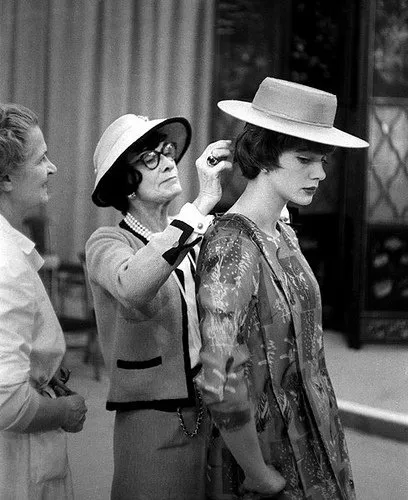
photo/fashiondigitalmarketingagency
The Opening of Chanel Boutique
In 1913, Coco Chanel expanded her business and opened boutiques in Deauville and Biarritz. Deauville, a chic seaside resort, was the perfect location for Chanel’s vision of relaxed, yet elegant fashion. Unlike the rigid and uncomfortable clothing of the time, Chanel’s designs emphasized comfort, simplicity, and elegance. She famously used jersey fabric, a material typically reserved for men’s undergarments, to create casual yet sophisticated dresses that allowed women to move freely. Chanel’s designs liberated women from the constraints of corsets and excessive layers of fabric, offering them a new sense of freedom and modernity. The success of her boutiques laid the foundation for what would become one of the most influential fashion empires in history.
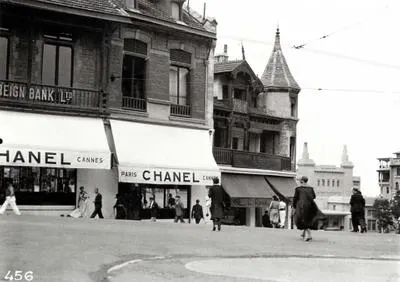
The Couture House in Biarritz, 1931/photo/chanel
Redefining Women’s Fashion
Coco Chanel’s approach to fashion was revolutionary. She believed that clothes should not only be beautiful but also practical and comfortable. Her designs were all about freeing women from the restrictive, corseted silhouettes that had dominated fashion for centuries. Instead of dressing women like dolls, Coco Chanel dressed them like individuals, with sleek, minimalist lines and fabrics that moved with the body. She famously said, “Luxury must be comfortable, otherwise it is not luxury,” a philosophy that defined her entire career. Chanel’s use of jersey fabric was groundbreaking at the time, as it was a material typically used for men’s underwear. However, in Chanel’s hands, it became the epitome of casual elegance, symbolizing the new, modern woman who was independent, active, and confident.

photo/agnautacouture
Coco Chanel’s Notable Collections and Works
Chanel No. 5 – A Revolution in Perfume: The Creation of an Icon
In 1921, Coco Chanel launched what would become one of the most iconic fragrances of all time—Chanel No. 5. Unlike other perfumes that were composed of single floral notes, Chanel No. 5 was a complex, multi-layered fragrance with a blend of over 80 ingredients, including jasmine, rose, and sandalwood. Collaborating with perfumer Ernest Beaux, Chanel aimed to create a scent that was not just a perfume but an identity. She wanted a fragrance that represented the modern woman—bold, independent, and unforgettable. The name “No. 5” was chosen because it was the fifth sample Beaux presented to Chanel, and she believed in the power of numbers and simplicity. The fragrance broke all the rules, just like Chanel herself.

photo/alicefmp
Enduring Popularity of Chanel No. 5
Chanel No. 5 didn’t just change the world of perfume; it became a cultural phenomenon. In the decades since its launch, it has been worn by some of the most famous women in the world, including Marilyn Monroe, who famously declared that she wore nothing to bed but “a few drops of No. 5.” The perfume’s popularity endures to this day, with millions of bottles sold each year. Its timeless appeal lies in its unique blend of femininity and strength—much like Coco Chanel herself. Chanel No. 5 is more than just a fragrance; it’s a symbol of luxury, sophistication, and empowerment.
The 2.55 Quilted Bag
In 1955, Chanel introduced the 2.55 quilted handbag, another of her iconic creations. At the time, handbags were typically hand-carried, but Chanel, always thinking of practicality, designed a shoulder bag that allowed women to move more freely. The quilted design was inspired by the jackets worn by stable boys, and the chain strap was both a functional and stylish feature. The bag also included a hidden pocket for storing personal items—a touch of mystery that was quintessentially Chanel. The 2.55 bag is still in production today and has been reinterpreted in various materials and colors, but its classic design remains largely unchanged.
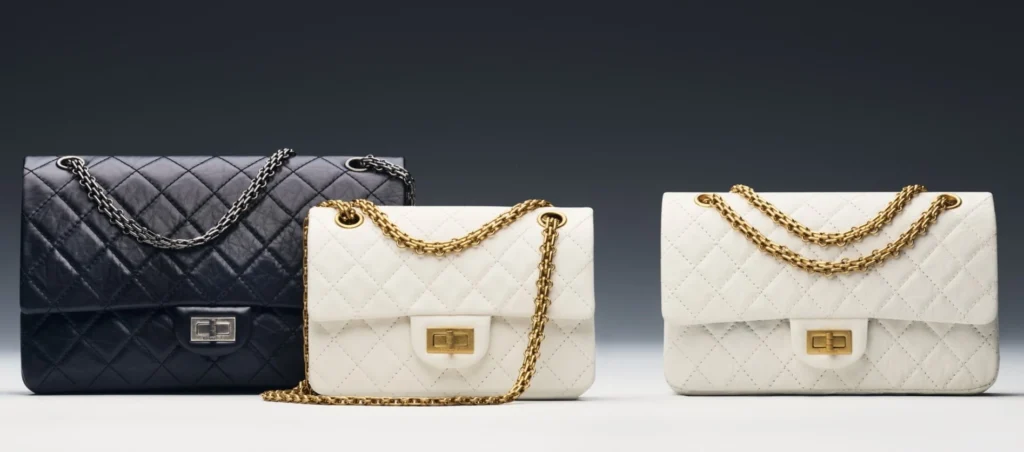
photo/chanel
The Breton Stripe Top
Coco Chanel is credited with popularizing the Breton stripe top, a piece inspired by the uniforms of French sailors. In the 1910s, Chanel took this traditionally masculine garment and transformed it into a stylish yet casual piece for women. Paired with wide-leg trousers, the Breton stripe top became a symbol of effortless chic and is now a timeless wardrobe staple. This simple yet striking piece reflects Chanel’s knack for borrowing elements from menswear and making them elegant and wearable for women.

photo/cntraveler
The Costume Jewelry Revolution
Chanel also revolutionized the world of costume jewelry. Before Chanel, jewelry was seen as a marker of wealth, with precious metals and stones dominating the fashion world. Chanel, however, believed that jewelry should be fun and accessible to all women, not just the wealthy. She introduced costume jewelry, creating pieces that were bold, stylish, and affordable. Pearls, long chains, and large, decorative brooches became signatures of her collections, allowing women to accessorize without breaking the bank. Chanel herself often wore multiple layers of pearls, mixing real and faux, making a bold statement that jewelry was about style, not status.

photo/truefacet
Chanel’s Haute Couture Collections
Throughout her career, Chanel produced numerous haute couture collections that challenged the conventions of fashion. After her comeback in the 1950s, Chanel’s haute couture pieces became symbols of timeless elegance. Her collections often featured structured suits, elegant evening gowns, and minimalist daywear that appealed to women who wanted both beauty and functionality. Chanel’s use of tweed, jersey, and other unexpected fabrics in couture further solidified her reputation as a designer who was unafraid to break the rules. Many of her haute couture pieces remain iconic, influencing countless designers in the years that followed.





Also Read – Nina Ricci: A Legacy of Timeless Elegance and Feminine Allure
World War II and Controversies
Life During the War
World War II was a challenging period for Chanel. In 1939, Coco Chanel closed her fashion houses, claiming that “war was not a time for fashion.” However, her personal life during the war raised eyebrows, particularly her relationship with a Nazi officer, Hans Günther von Dincklage. Chanel lived at the Ritz Hotel in Paris throughout the German occupation, a decision that would haunt her later in life. After the war, she was accused of being a collaborator, a claim that damaged her reputation. She fled to Switzerland for several years to avoid the controversy, but the shadows of her wartime choices would continue to follow her.

photo/nytimes
Controversies and Allegations
Coco Chanel’s relationship with von Dincklage and her activities during the war have been the subject of much speculation and controversy. Some claim she used her influence to negotiate with the Nazis to regain control of her perfume business, which had been taken over by the Jewish Wertheimer family. Others argue that her actions were purely for personal survival. Regardless of the truth, these allegations have cast a complex and somewhat darker light on Chanel’s legacy. Despite the controversies, however, Chanel remained a formidable force in fashion, and her influence continued to grow in the post-war years.
Coco Chanel’s Impact on Fashion
The Little Black Dress (LBD)
Perhaps one of Coco Chanel’s most famous contributions to fashion is the creation of the Little Black Dress (LBD). Introduced in 1926, the LBD was revolutionary for its time. Prior to Chanel, black was reserved for mourning and was not considered fashionable or elegant. Chanel took this “mourning” color and transformed it into the epitome of chic. The LBD was simple, versatile, and accessible to women of all social classes. Vogue magazine called it “Chanel’s Ford,” comparing its simplicity and ubiquity to the Model T car. Chanel believed that a woman could never be overdressed or underdressed in a simple black dress. This timeless piece is still a staple in women’s wardrobes today, proving Chanel’s genius for designing fashion that transcends time and trends.
The LBD was a symbol of empowerment for women, offering them an outfit that could be dressed up or down depending on the occasion. It also challenged the overly ornate and restrictive fashions of the time, offering women freedom and elegance in one simple garment. The LBD continues to be a go-to choice for women around the world, reflecting the lasting influence of Chanel’s minimalist and practical approach to fashion.

photo/etoile-luxuryvintage
The Chanel Suit – A Symbol of Empowerment
The Chanel suit, introduced in the 1920s, is another iconic piece that redefined women’s fashion. Made from wool and typically paired with a collarless jacket and a knee-length skirt, the suit was designed to offer women comfort without sacrificing elegance. Chanel was inspired by menswear and military uniforms, and her suits reflected this influence, providing women with structured yet fluid silhouettes. The design allowed women to move freely, breaking away from the tight corsets and restrictive clothing that had dominated previous eras. It was a suit for the modern woman—one who worked, traveled, and embraced her independence.

photo/nytimes
What made the Chanel suit revolutionary was its practicality. Unlike the stiff, formal suits of the time, Chanel’s version allowed women to be comfortable while still looking stylish and professional. It was a reflection of the changing role of women in society, as more women entered the workforce and gained independence. The Chanel suit became a symbol of empowerment, and it remains an iconic piece that represents both style and strength.
Timeless Fashion Philosophy
Chanel’s fashion philosophy was simple: less is more. She rejected the excessive frills, corsets, and elaborate designs that had dominated fashion, instead opting for clean lines and functional elegance. Chanel believed that true luxury was about comfort and simplicity, and her designs reflected that ethos. She once said, “Simplicity is the keynote of all true elegance.” This mantra not only guided her clothing designs but also her accessories, makeup, and fragrances.
Chanel’s philosophy of timeless fashion is what has allowed her brand to remain relevant even decades after her death. Her pieces, whether it’s the LBD, the Chanel suit, or the classic quilted handbag, are as desirable today as they were when they were first created. Her emphasis on simplicity and functionality, paired with elegance, continues to inspire designers around the world. Chanel’s designs were more than just clothes; they were statements about the modern woman’s place in society—strong, independent, and unapologetically herself.
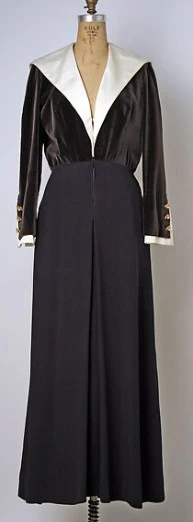
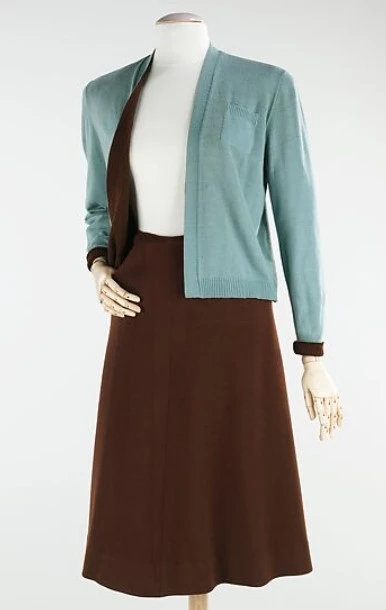


photo/metmuseum
Coco Chanel’s Personal Life
Romantic Relationships
Coco Chanel’s personal life was as fascinating and complex as her designs. Over the years, she had numerous high-profile relationships with influential men, including Boy Capel, a wealthy Englishman who financially supported her early career, and the Duke of Westminster, one of the richest men in the world. Though she never married, these relationships played a significant role in shaping her life and career. Chanel’s relationship with Capel was particularly significant; he was the love of her life and encouraged her to pursue her dreams. His tragic death in a car accident left a lasting scar on Chanel, but it also fueled her ambition to succeed and solidify her place in the world.

Coco Chanel and Boy Capel/photo/luxuryactivist
Despite the romances, Chanel was fiercely independent. She famously declared, “I never wanted to weigh more heavily on a man than a bird.” Her relationships with powerful men opened doors for her, but it was her talent, vision, and determination that made her an icon. Chanel’s refusal to conform to traditional gender roles extended beyond her designs; she lived her life on her own terms, breaking barriers both in her personal life and in the fashion world.
Personal Struggles Behind the Fame
Despite her success, Chanel’s life was not without hardship. Her childhood in an orphanage, the abandonment by her father, and the loss of Boy Capel deeply affected her. Chanel’s tough exterior often masked a more vulnerable side, and throughout her life, she struggled with loneliness and loss. Her involvement with the Nazi regime during World War II also left a stain on her legacy, and after the war, she was forced to retreat to Switzerland to avoid public backlash. However, even these controversies could not diminish her influence in the fashion world.
Chanel’s resilience in the face of adversity is a testament to her strength and determination. She once said, “My life didn’t please me, so I created my life.” And create she did—transforming not only her own circumstances but also the way women dressed and lived. Chanel’s personal struggles were woven into the fabric of her designs, making them all the more powerful and enduring.
Return to Fashion
Comeback in the 1950s
After a period of retreat following World War II, Chanel made a triumphant return to the fashion world in 1954, at the age of 71. Her comeback was met with mixed reactions; while French critics were initially lukewarm, the American fashion press hailed her return as a revival of her revolutionary vision. Chanel’s return to the runway was a bold move, and it signaled that she was not done reshaping the fashion world.
The 1950s were a period of conservative, ultra-feminine fashion, dominated by Christian Dior’s “New Look,” which emphasized full skirts and tiny waists. Chanel, however, stayed true to her minimalist roots, rejecting the overtly feminine silhouettes of the time in favor of her timeless, simple designs. Her comeback collection featured the classic Chanel suit, which once again became a symbol of elegance and empowerment for women. Chanel’s ability to stay relevant and true to her vision, even in the face of changing fashion trends, is a testament to her genius as a designer.

photo/britannica
Continuing Influence on Modern Designers
Coco Chanel’s influence on fashion continues to this day. Designers from Karl Lagerfeld, who took over as creative director of Chanel in 1983, to contemporary designers like Stella McCartney and Phoebe Philo, have drawn inspiration from Chanel’s work. Her emphasis on simplicity, elegance, and practicality has become a guiding principle for many in the fashion industry. The Chanel brand remains one of the most prestigious in the world, known for its high-quality craftsmanship, iconic designs, and timeless appeal.
Chanel’s impact extends beyond her own brand. Her designs have influenced the entire fashion industry, shaping the way modern women dress and think about fashion. Her legacy lives on in the way women today embrace clothing that is both functional and beautiful, proving that Chanel’s vision of the modern woman is still as relevant as ever.
The Legacy of Gabrielle Chanel
How She Changed Women’s Roles in Society
Chanel’s designs did more than just change the way women dressed; they changed the way women lived. By creating clothing that was both stylish and functional, Chanel gave women the freedom to move, work, and live with confidence. She rejected the idea that fashion had to be restrictive or impractical and instead created pieces that reflected the needs and desires of the modern woman. Chanel’s designs were a reflection of the changing role of women in society during the early 20th century, as more women began to work, gain independence, and assert their place in the world.
Chanel’s influence extended beyond fashion. She became a symbol of the independent, modern woman who lived life on her own terms. Her boldness, creativity, and refusal to conform to societal expectations continue to inspire women today. Chanel once said, “A girl should be two things: who and what she wants.” This philosophy of empowerment is at the heart of Chanel’s legacy, and it remains a powerful message for women around the world.
Influence on Today’s Fashion Industry
The fashion industry today owes much of its modernity to Coco Chanel. Her insistence on simplicity, functionality, and elegance has become a cornerstone of contemporary fashion. Many of today’s top designers continue to draw inspiration from her designs, from the timeless Chanel suit to the elegant LBD. Chanel’s belief that fashion should be comfortable, practical, and beautiful is now a standard in the industry.
Even decades after her death, Chanel remains a central figure in the world of fashion. The brand she built continues to thrive, and her designs are as coveted today as they were when she first introduced them. Chanel’s legacy is not just in the clothes she designed, but in the way she transformed the fashion industry, empowering women to dress in a way that reflects their independence, confidence, and style.


NYC Store(left)/London Store(right)/photo/town&countrymagazine/chanel
Coco Chanel at a Glance:
| Section | Key Points |
|---|---|
| Introduction | Overview of Gabrielle “Coco” Chanel’s life and revolutionary impact on fashion. |
| Early Life and Career Beginnings | – Born in 1883 in France. |
| – Raised in an orphanage where she learned to sew. | |
| – Opened her first hat shop in Paris in 1910. | |
| Rise to Fame | – Revolutionized women’s fashion with simple, comfortable designs. |
| – Key innovations: Little Black Dress (LBD) and Chanel suit. | |
| – Expanded into accessories and perfumes (Chanel No. 5). | |
| Chanel No. 5 Perfume | – Introduced in 1921, became a global phenomenon. |
| – A blend of floral and synthetic fragrances. | |
| – Marketing and celebrity endorsements played a key role. | |
| World War II and Controversy | – Closed her fashion house during WWII, claiming “war was not a time for fashion.” |
| – Relationship with Nazi officer Hans Günther von Dincklage caused allegations of collaboration. | |
| – Fled to Switzerland post-war due to backlash. | |
| Controversies and Allegations | – Chanel’s alleged negotiations with Nazis for control of her perfume business. |
| – Continued debates on whether her actions were for personal survival or collaboration. | |
| The Little Black Dress (LBD) | – Introduced in 1926, became a symbol of elegance and versatility. |
| – Black was traditionally for mourning, but Chanel transformed it into a fashion staple. | |
| The Chanel Suit | – Introduced in the 1920s, reflecting military influence with a focus on comfort and style. |
| – Became a symbol of women’s empowerment and modernity. | |
| Fashion Philosophy | – Emphasized simplicity, comfort, and elegance: “Simplicity is the keynote of all true elegance.” |
| Romantic Relationships | – Key relationships with Boy Capel (who helped her early career) and the Duke of Westminster. |
| – Capel’s death in a car accident had a lasting impact on her life. | |
| Personal Struggles | – Abandonment by her father, loss of Capel, and loneliness marked her personal life. |
| – Controversies related to Nazi collaboration affected her reputation. | |
| Comeback in the 1950s | – Returned to fashion at the age of 71, despite mixed initial reactions. |
| – American fashion press hailed her revival. | |
| Continuing Influence | – Influenced designers like Karl Lagerfeld, Stella McCartney, and Phoebe Philo. |
| – Chanel’s brand remains prestigious and her designs remain relevant today. | |
| Legacy of Gabrielle Chanel | – Changed women’s fashion by introducing comfortable, functional clothing. |
| – Became a symbol of female empowerment and modernity. | |
| 2. Influence on women’s fashion: Comfortable, practical designs that broke traditional norms. | |
| 3. Controversies during WWII: Allegations of collaboration with Nazis. | |
| 4. Fashion philosophy: Simplicity, comfort, and elegance. |
Conclusion
Gabrielle Bonheur Chanel, or Coco Chanel, was more than just a fashion designer—she was a visionary who revolutionized the way women dressed and lived. From her humble beginnings in an orphanage to her rise as one of the most influential figures in fashion, Chanel’s life was defined by her ambition, creativity, and determination. Her designs, from the Little Black Dress to the Chanel suit, remain iconic symbols of elegance and empowerment. Chanel’s influence continues to shape the fashion industry today, and her legacy as a pioneer of modern fashion is firmly cemented in history. Coco Chanel didn’t just design clothes; she designed a new way of life for women, one that was independent, bold, and unapologetically stylish.
FAQs
1. What was Coco Chanel’s most famous design?
Coco Chanel is best known for creating the Little Black Dress (LBD) and the Chanel suit, both of which are iconic symbols of timeless fashion.
2. How did Coco Chanel influence women’s fashion?
Chanel revolutionized women’s fashion by introducing comfortable, functional designs that allowed women to move freely. She rejected restrictive clothing like corsets and emphasized simplicity, elegance, and practicality.
3. Why was Coco Chanel’s wartime activity controversial?
During World War II, Chanel was accused of collaborating with the Nazis, largely due to her relationship with a Nazi officer. These allegations damaged her reputation, and she spent several years in exile in Switzerland after the war.
4. What was Chanel’s fashion philosophy?
Chanel’s fashion philosophy was based on simplicity and elegance. She believed that less is more and that true luxury comes from comfort and functionality.
5. How did Coco Chanel make her comeback in the 1950s?
Chanel made a comeback in 1954, reintroducing her classic designs like the Chanel suit. While her return was initially met with mixed reviews, her timeless style quickly regained popularity, particularly in the United States.
One thought on “How Coco Chanel’s Vision Transformed Women’s Fashion Forever”